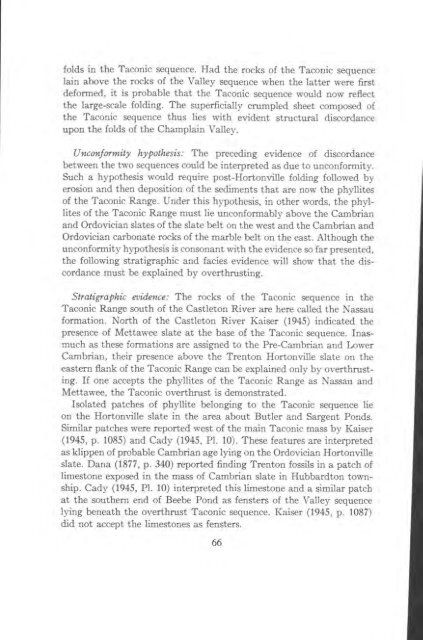STRATIGRAPHY AND STRUCTURE CASTLETON AREA VERMONT
STRATIGRAPHY AND STRUCTURE CASTLETON AREA VERMONT
STRATIGRAPHY AND STRUCTURE CASTLETON AREA VERMONT
Create successful ePaper yourself
Turn your PDF publications into a flip-book with our unique Google optimized e-Paper software.
folds in the Taconic sequence. Had the rocks of the Taconic sequence<br />
lain above the rocks of the Valley sequence when the latter were first<br />
deformed, it is probable that the Taconic sequence would now reflect<br />
the large-scale folding. The superficially crumpled sheet composed of<br />
the Taconic sequence thus lies with evident structural discordance<br />
upon the folds of the Champlain Valley.<br />
Unconformity hypothesis: The preceding evidence of discordance<br />
between the two sequences could be interpreted as due to unconformity.<br />
Such a hypothesis would require post-Hortonville folding followed by<br />
erosion and then deposition of the sediments that are now the phyllites<br />
of the Taconic Range. Under this hypothesis, in other words, the phyllites<br />
of the Taconic Range must lie unconformably above the Cambrian<br />
and Ordovician slates of the slate belt on the west and the Cambrian and<br />
Ordovician carbonate rocks of the marble belt on the east. Although the<br />
unconformity hypothesis is consonant with the evidence so far presented,<br />
the following stratigraphic and facies evidence will show that the discordance<br />
must be explained by overthrusting.<br />
Stratigraphic evidence: The rocks of the Taconic sequence in the<br />
Taconic Range south of the Castleton River are here called the Nassau<br />
formation. North of the Castleton River Kaiser (1945) indicated the<br />
presence of Mettawee slate at the base of the Taconic sequence. Inasmuch<br />
as these formations are assigned to the Pre-Cambrian and Lower<br />
Cambrian, their presence above the Trenton Hortonville slate on the<br />
eastern flank of the Taconic Range can be explained only by overthrusting.<br />
If one accepts the phyllites of the Taconic Range as Nassau and<br />
Mettawee, the Taconic overthrust is demonstrated.<br />
Isolated patches of phyllite belonging to the Taconic sequence lie<br />
on the Hortonville slate in the area about Butler and Sargent Ponds.<br />
Similar patches were reported west of the main Taconic mass by Kaiser<br />
(1945, p. 1085) and Cady (1945, P1. 10). These features are interpreted<br />
as klippen of probable Cambrian age lying on the Ordovician Hortonville<br />
slate. Dana (1877, p. 340) reported finding Trenton fossils in a patch of<br />
limestone exposed in the mass of Cambrian slate in Hubbardton township.<br />
Cady (1945, P1. 10) interpreted this limestone and a similar patch<br />
at the southern end of Beebe Pond as fensters of the Valley sequence<br />
lying beneath the overthrust Taconic sequence. Kaiser (1945, p. 1087)<br />
did not accept the limestones as fensters.<br />
66













